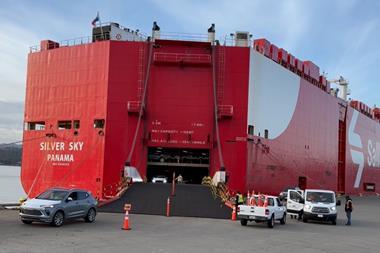
In the same week the Renault Nissan Alliance announced that imports to the UK for both Nissan and Renault are being consolidated through the port of Tyne, also in the Northeast of the England. Renault formerly used on the port of Teesport as its regional entry point for vehicles (read more here).
The launch of the Leaf at Sunderland, which was attended by the UK’s prime minister David Cameron, follows four years of preparation including the building of a lithium-ion battery plant adjacent to the Sunderland plant. The Leaf project represents a total investment of £420m ($635m) in battery and vehicle production. The Leaf is fully integrated on the same production line that makes the Qashqai, with the same staff building both vehicles, and is tested and transported in the same way.
“The reason we moved the Leaf here was, one: to avoid the yen exposure associated with bringing cars in from Japan, which has been and still is to a certain extent a problem,” said John Martin, Nissan’s senior vice president, manufacturing, purchasing and supply chain management for Europe. “Secondly, because the major market for the car is continental Europe, we need to be close to the market, which this plant is.”
The company would not comment on projected Leaf output for the coming year but expected to increase sales because of the improvements on the second generation Leaf, including an increased range of 199km and a halving of recharging time to four hours. The company has made 100 updates to the new model, including reductions in rare earth materials and the use of steel instead of aluminium on the doors. Weight savings of 50kg have been made, which has contributed to increased driving range.
In total last year the Sunderland plant made approximately 510,500 vehicles, including Qashqai, Juke and Note, the first time a UK plant has crossed the 500,000-unit threshold. One in every three cars made in the UK is produced at Sunderland.
Over the same period the company sold 6,500 Leafs in Europe, all imports from Japan.
Supplying Sunderland
In terms of the supply base, around 34% of the Leaf’s content is sourced from the UK, while 90% comes from wider Europe. According to Martin, Nissan would like to see more UK content but the supply base is still lagging the resurgence in automotive manufacturing in the country.
“The suppliers took a large hit when the likes of Rover shut down,” he said, referring to the British brand that was liquidated in 2005. “Getting those suppliers back in after they have already installed capacity in Europe is a difficult job.”
He added that he was working with Nissan’s Kevin Fitzpatrick, vice president, manufacturing UK, who sits with him on the UK’s Automotive Council, to do just that. “There are a lot of advantages to coming back,” he said. “One, you are close to the manufacturers and two, you have a flexible workforce. And our unit costs are very competitive.”
Nissan will still import the expensive electrode used in the battery from Japan. This is made by its joint venture with NEC called Automotive Energy Supply Corporation (AESC), based at Nissan’s facility in Zama, Kanagawa Prefecture. Although Martin, who had previously been based in Japan, recognised the risks that accompany such a sourcing strategy given the disruptions that followed the 2011 tsunami in Japan and the surge in the yen’s value last year, he said that Nissan had no need to localise the electrode in the UK until volumes rose sufficiently. But Nissan will eventually source the component in the UK, he said.
“I was the guy in charge of recovery from the Japanese earthquake so it is a lesson that is not lost on me,” he said. “But the problem you’ve got is that it is newly developing technology, so you generally don’t roll it out unless you are extremely sure it is stable and well understood.”
Japanese production of the batteries has seen a defect rate of fewer than 10 out of 60,000 produced, according to Martin. He added that Zama was in a relatively stable location in terms of Japan’s earthquake fault lines.
As well as local Leaf production, the Sunderland battery plant will supply Nissan’s Barcelona plant where it builds a new compact van and will start production later this year of an electric taxi version.
Despite the level of new technology involved and the movement of expensive components, such as the electrode from Japan, Nissan has been able to accommodate the flow of materials within its existing logistics set up, which involves inter-regional parts consolidation centres around the world.
“Specifically for the Leaf [a multi-plant sourced model], because the plant was in Japan, some parts were sourced there and they will come through our Japanese parts consolidation centre,” said Paul Maddison, Alliance Logistics Europe general manager. “They are then shipped via the port of Tyne and into our warehouses, either at the port or here on Turbine Business Park, within a kilometre of the plant. That is particularly interesting for us logistically. It allows us to have the best fill rates globally on our trucks considering our Nissan and Renault Plants. So we have the full bulk deliveries to a deconsolidation centre and then lean delivery to the plant, typically on the hour.”
In terms of local supply chain development, Nissan organises a local Northeast Logistics Scheme, for provision within 50kms of the plant, and a wider UK scheme.
“The Northeast scheme delivers direct to the plant and [these deliveries] fall within our reduced order lead time window,” said Maddison. “The deliveries that come in are precisely on time with the parts we are going to consume measured by our MRP system. This looks at precisely the number of parts we have line-side at that point. The UK logistics scheme will go into our consolidation warehouse and be reconsolidated into hourly deliveries.”



































